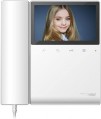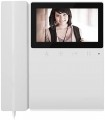Number of ports
The total number of ports for wired connection of various equipment provided in the intercom; in fact — the maximum number of wired devices that can be simultaneously connected to the intercom.
Keep in mind that this number may be less than the total amount of supported devices. This is especially true in models with the possibility of using additional monitors (see "Connected monitors"): such devices are often connected in series, "chained" and occupy only 1 port. Thus, for example, an intercom for 2 calling panels and 3 monitors can have only 3 connectors — one for calling panels and one for monitors. Note also that the LAN port in IP intercoms (see "Device type") is also taken into account in this calculation.
Pluggable outdoor panels
The number of outdoor panels that can be connected to the intercom at the same time.
The call panel is an external panel through which the guest sends a call to the owner of the intercom and communicates with him. Such a panel should be at each door "covered" by the intercom. This means that the number of supported outdoor panels corresponds to the maximum number of doors with which this model can be used. The simplest option is
1 calling panel, but in fact this is often not enough. Therefore, models that can block
2 doors at once are more popular — for example, the main and service entrances to the office. And in the most advanced intercoms, it may be possible to connect
4 calling panels at once, or even
more.
Connected video cameras
The number of video cameras that can be simultaneously connected to the intercom. The mode of operation with these cameras can be different — a mosaic of several signals at once, switching between signals with each one displayed on the full screen, etc. However, anyway, to work with several video cameras, it is desirable that their corresponding number be directly claimed in the intercom — otherwise you will have to resort to installing additional equipment.
The simplest modern intercoms allow the connection
of 1 or
2 cameras, in more advanced ones this number can reach
4 or
more.
Consumption (standby)
The amount of energy consumed by the intercom in standby mode. In this mode, the device is energized and is in a state of readiness to receive a call; no functions are used, and the readiness itself does not require a lot of energy. Therefore, the value of this parameter, usually, is rather low, and you should pay attention to it only if you fundamentally strive for maximum efficiency of the installed equipment.
Consumption (during operation)
Power consumption of the intercom in the operating mode. Usually, this item indicates the value for situations where the device's functions are used to the fullest — in particular, when the display is on and the speakerphone is on (if any, see above). Note that the consumption in the operating mode rarely exceeds 20 W, so in most cases it is more of a reference, and not a practically significant parameter.

